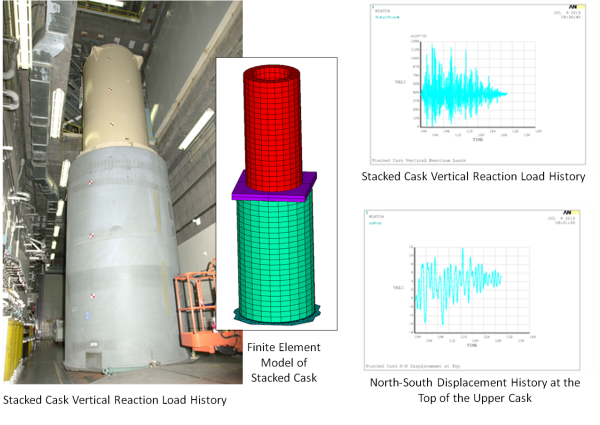Seismic Evaluation of Stacked Spent Nuclear Fuel Casks and Support Structure for Dynamic Stability and Increased Floor Loads
Unloading of spent nuclear fuel at nuclear utilities typically involves removing spent fuel from the spent fuel pool and placing it in casks for interim on-site storage. During unloading, some utilities use what is known as a “stacked cask” configuration in which a transfer cask is temporarily stacked on top of a storage cask as illustrated. During the time the casks are in the stacked cask configuration, they must be shown to remain stable during postulated earthquakes and the support structure or floor loads must be acceptable. This evaluation is performed as a response history analysis in the time domain using the general-purpose finite element code ANSYS®. The idealized model consists of shell, solid, beam, contact, spring-damper, and concentrated mass elements. The limiting parameters are the peak displacement near the top of the stack and the maximum floor loads. The response history approach allows the analyst to extract the rocking angles, the sliding displacements, the margin against overturning, and the peak vertical reaction forces, which are an indicator of floor loads. The evaluations are performed for a range of friction coefficients between the bottom of the lower cask and the supporting railway dolly. In general, lower friction coefficients lead higher sliding displacements, and higher friction coefficients result in greater rocking angles. The range of friction coefficients covers the uncertainty inherent in characterizing friction coefficients.
As expected, the simulations show that the maximum displacement at the top of the stack occurs primarily from rocking for the higher friction coefficients and primarily from sliding for the lower friction coefficients. In all cases, the maximum displacement remains within an acceptable range.
However, in some cases, peak reaction forces exceeded the limits for which the supporting structure was previously qualified. In the first step of the evaluation, the support structure is assumed to be rigid in the dynamic model. This assumption implies that the peak reaction loads will correspond to actual floor loads only if the supporting structure is rigid. In reality, the supporting structure, while very stiff, is not rigid. To determine the effect of floor flexibility on the peak reaction forces, a separate model of the support structure is utilized. Including the effect of floor flexibility in the model has the potential to either increase or decrease the predicted floor loads. Because the dynamic cask model and the model of the support structure are decoupled, the initial evaluation was conducted by extracting peak reaction forces from the rigid base dynamic cask model and applying those loads statically to the support structure model. The support structure model is then used to determine if the loads in the floor are acceptable. However, the use of a rigid base model must be justified. This is accomplished by adding the stacked cask mass to the support structure model. A modal analysis is performed to determine the effective mass in the vertical direction associated with the fundamental vertical mode of the cask/floor system. Equivalent floor flexibilities are extracted and the dynamic cask model is modified to include the effective cask mass and floor flexibility. This allows the dynamic properties of the support structure to be simulated in the dynamic model, albeit in a simplified manner. Finally, the peak floor forces from the modified dynamic model are applied to the support structure model as static loads and the floor demands are compared to the earlier results. This process captures the effects of floor flexibility and it shows that the initial simplifying assumption of treating the floor as rigid in the dynamic model is sufficiently accurate and that the demands on the support structure are acceptable with either approach.
The re-evaluation and re-qualification of the floor for increased loads allowed continued operations without costly and time consuming plant modifications.
 [readon2 url=”index.php?option=com_rsform&view=rsform&formId=4&Itemid=620″]Click to Request Info[/readon2]
[readon2 url=”index.php?option=com_rsform&view=rsform&formId=4&Itemid=620″]Click to Request Info[/readon2]






